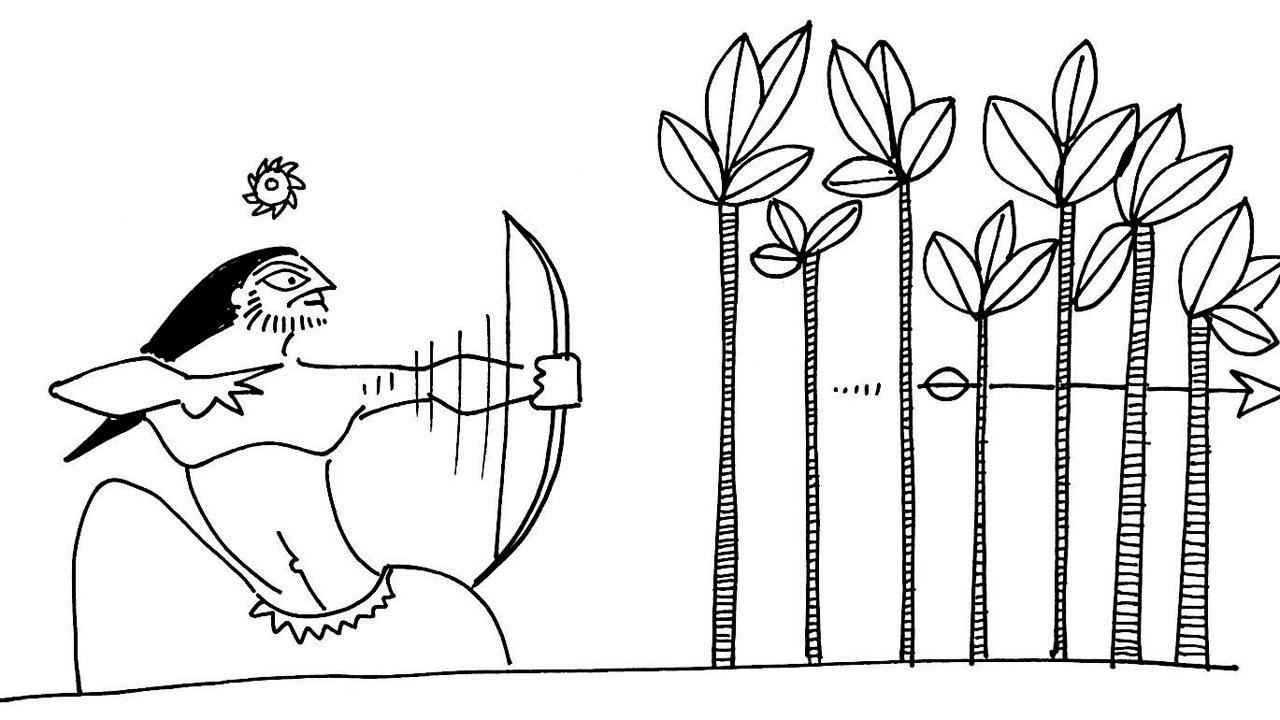This is why the monkeys refuse to travel by boat to Lanka, but insist on building a bridge.

Illustration/Devdutt Pattanaik
 In the Uttar Ramayana, we hear of Ravana’s genealogy. From his father’s side, he is Vaishravana (son of Vishrava) and Paulatsya (descendant of Pulatsya). He shares these paternal surnames with Kubera, his half-brother, who he displaces as king of Lanka. His mother is Kaikesi, daughter of Sumali, whose surname is Salakatantaka, resident of the dense Sal forests.
In the Uttar Ramayana, we hear of Ravana’s genealogy. From his father’s side, he is Vaishravana (son of Vishrava) and Paulatsya (descendant of Pulatsya). He shares these paternal surnames with Kubera, his half-brother, who he displaces as king of Lanka. His mother is Kaikesi, daughter of Sumali, whose surname is Salakatantaka, resident of the dense Sal forests.
ADVERTISEMENT
This is very significant, because the Sal tree grows in Jharkhand, Chhattisgarh and Odisha but not in Sri Lanka. Scholars have been clear that early Ramayana texts refer to a geography that does not go south of the Vindhyas or Narmada, as is popularly believed. When Sugriva describes the geography of India, he states that Kishkinda is to the north of Narmada and Vindhya, east of Mahanadi. In the oldest manuscript, Ramayana’s geography stretches between the Ganga river plains and the dense Sal forests to its south. The ocean was probably a vast water body (dug by the sons of Sagara) filled with crocodiles that monkeys fear the most. This is why the monkeys refuse to travel by boat to Lanka, but insist on building a bridge.
Lanka was probably a spot near Amarkantak in Madhya Pradesh, where local Gond tribal kings called themselves descendents of Paulatsya. Or maybe it was Odisha, where there is the temple of Lankeshwari and the famous Subarnarekha river, famous for panned gold. Did that give rise to the myth of the golden city? We can speculate endlessly, but for today’s Hindu, Lanka is Sri Lanka, since the time of Chola kings (10th century) and Kishkinda is in Karnataka since the time of the Vijayanagar Empire (15th century).
The Sal forests to the south of the Ganga river basin has great significance in Indian mythology. It is the tree under which the Jain Tirthankar, Mahavir, attained the highest state of omniscience or Kevagyan. Holding one of the branches of the Sal tree, during her labour pains, Buddha’s mother delivered her illustrious son. Buddha died between two Sal trees. Two of the many Buddhas who came before attained enlightenment under the Sal tree. So, Sal trees have been associated not just with Ravana but also with the monastic orders, Buddhism and Jainism, who were challenging the Vedic ritualism. Ram is a supporter of the Vedic religion and Brahmins. Ram shoots an arrow through seven Sal trees to prove his strength to Sugriva. Was this a symbolic counter of the Vedic king to monastic orders?
Salakatantaka is a name that occurs in the Griha-sutras. It is one of the names of the four Vinayakas who cause trouble. They prevent women from marrying and men from being successful. In effect, Salakatantaka is associated with malevolent spirits. It is but natural that this name started being attributed to the rakshasas who opposed the Vedic people and eventually came to belong to Ravana.
Ram’s descendents were linked to sugarcane production. Hence, the dynasty was called Ikshavaku, a title later linked to the Buddha and to many Jain Tirthankaras. Even Buddhist rulers of Sri Lanka called themselves Okkaka, or Iskhavaku. Sugarcane indicated cultivated land and civilised kings. Kings wanted to distance themselves from the wild untamed Sal forests, realm of monks and demons.
The author writes and lectures on the relevance of mythology in modern times. Reach him at devdutt.pattanaik@mid-day.com
 Subscribe today by clicking the link and stay updated with the latest news!" Click here!
Subscribe today by clicking the link and stay updated with the latest news!" Click here!







